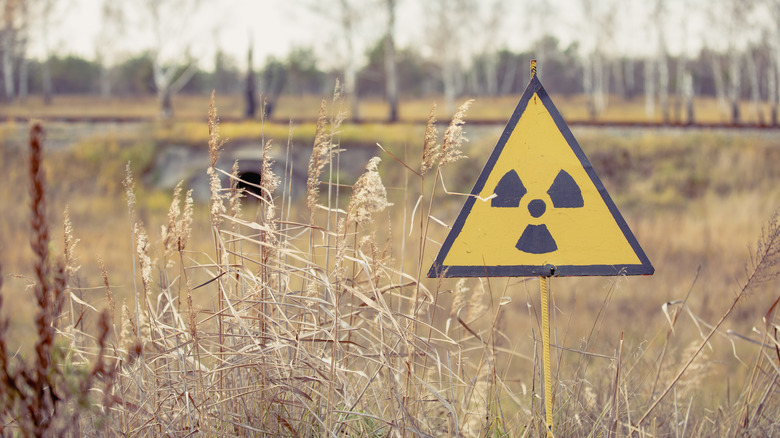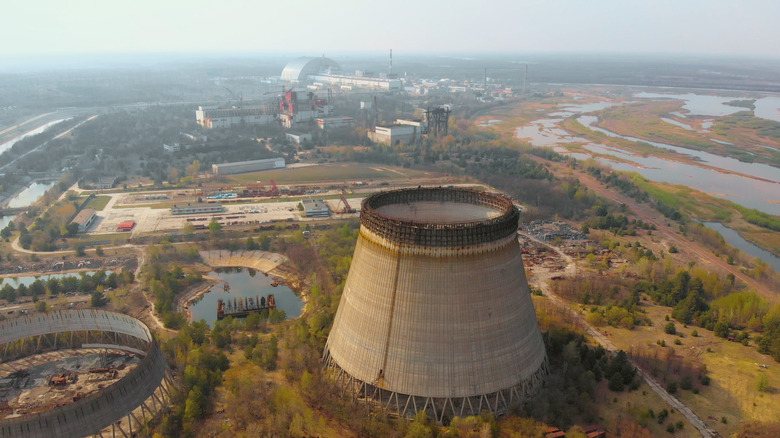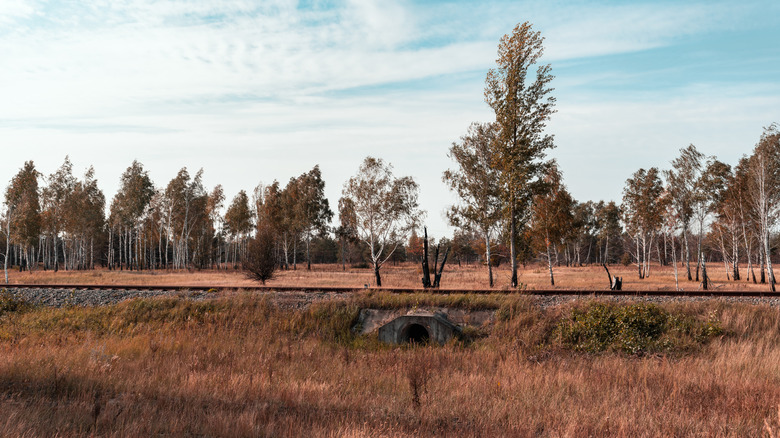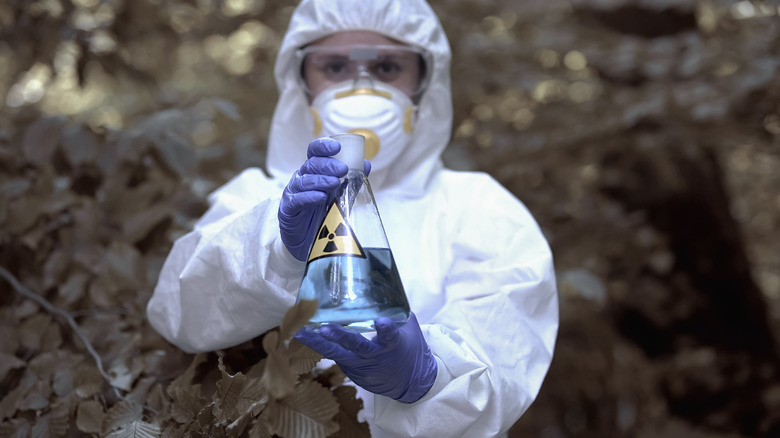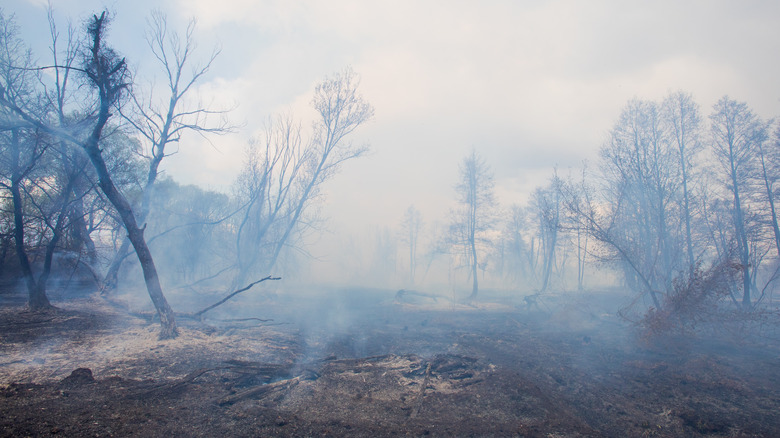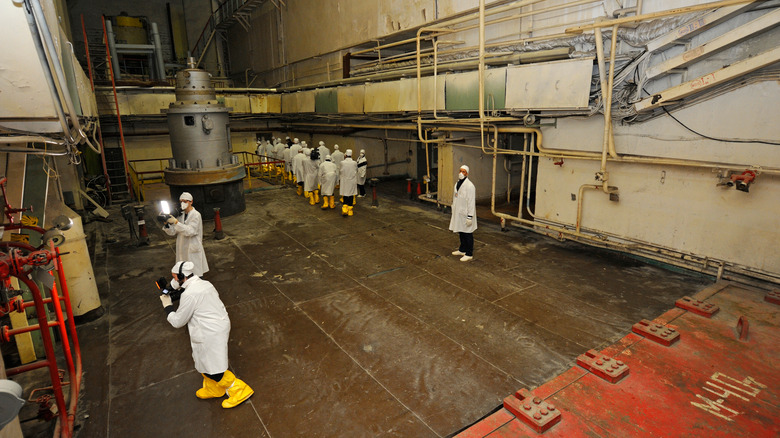What Is Chernobyl's Red Forest?
On April 26, 1986, a disaster struck at the nuclear power plant located in Chernobyl, Ukraine. The Chernobyl Power Complex had four nuclear reactors, and on April 25, crew members started preparing for tests to determine how long turbines would continue to spin after losing electrical power. According to the World Nuclear Association, a series of actions was done before the test, and by the time testing was scheduled to take place, the nuclear reactor was unstable. Still, the test proceeded; the immediate power surge caused a devastating explosion that left the nuclear core exposed, spreading radioactive materials into the air as a result.
Emergency personnel immediately descended on the scene to control the blaze. Sand and other materials were dumped on the affected areas to contain contamination. Per National Geographic, the catastrophic incident wasn't officially announced until April 28. About 335,000 people from nearby towns were evacuated, and a 19-mile-wide exclusion zone was established around the site of the explosion.
The effects of the explosion
The nuclear reactor explosion left two people dead immediately after, while 29 more died three months after the accident due to acute radiation sickness, as reported by Time. Hundreds more were treated for acute radiation syndrome — also called radiation toxicity — which occurs after exposure to a large dose of radiation in a short period of time (via Centers for Disease Control and Prevention). About 50 more people died of radiation toxicity, and those who survived — about 4,000 people — may die due to radiation exposure-related illnesses in the future.
Decades after the Chernobyl nuclear disaster, some people who were evacuated from the site are still reeling from the effects of radiation exposure. A study published in the Journal of Immigrant and Minority Health found that those who were exposed to radiation had more frequent hospital visits for eye conditions, endocrine issues, circulatory issues, and neoplasms or abnormal tissue growths in the body, per Israel21c. The number of thyroid cancer patients increased after the nuclear accident, and a majority of those affected were children and adolescents who lived in close proximity to the power plant.
The Red Forest
The Chernobyl nuclear disaster also left a lasting mark on the environment. One of the areas that had the most damage from the spread of the radiation into the atmosphere was the pine forest located west of the Chernobyl Power Complex. The forest — spanning about 400 hectares — was exposed to high doses of radiation that the effects were immediate. According to Chernobyl X, the majority of the trees in the forest died and turned a rusty red-orange color, and the area has been called the Red Forest since.
A study conducted on the Red Forest showed that the trees exposed to radiation — although dead — did not appear to be decaying even decades after the explosion, as reported by Smithsonian Magazine. Experiments were conducted, and based on the results, microbes and fungi — organisms that are important in the decomposition process — also remain contaminated, which hinders the process of decomposition. The Red Forest remains littered with dead trees and leaves and is one of the most radioactive places in Chernobyl.
Efforts to clean the Red Forest
Following the Chernobyl nuclear accident, clean-up operations immediately began. Workers who cleaned up powerplant and the surrounding areas that were contaminated were called liquidators, which included firefighters, emergency response personnel, members of the military, and non-professionals, according to The Chernobyl Gallery. The dangers that came with the task were mostly unknown to the team, but as one liquidator said, "somebody had to do it." It is estimated that at least 300,000 liquidators worked on the site, but it's possible that as many as 800,000 worked on cleaning up the area throughout the years.
The liquidators dedicated to the clean-up of the Red Forest had to bulldoze the trees that were contaminated. The trees and debris were then buried in trenches that were 2 to 3 meters deep and then covered with sand, per Chernobyl X. Shrubs and tree saplings were planted on top to prevent the sand from moving. Despite the clean-up efforts, many dead trees and leaves still remained on the site.
Disturbances in the Red Forest
In 2015, a forest fire set the Red Forest ablaze for days. The dead trees and litter of dead leaves quickly caught fire and 200 firefighters fled to the scene to control and stop the fire that spread to 12 miles from the powerplant, according to the BBC. The fire lasted for four days, but apart from the destruction, what was more concerning was the fact that the fire disturbed the land and sent radioactive particles into the atmosphere. Nuclear experts measured the presence of radioactive elements after the fire was put out and found that the level was 10 times worse than the typical readings (via Radio Free Europe).
In 2022, there was a reported disturbance in the Red Forest when Russian soldiers — amidst the Russia-Ukraine war — drove through the forest in their armored vehicles. According to witnesses, per Reuters, the soldiers were not wearing protective gear when they drove through the zone. The presence of military vehicles in the exclusion zone also greatly disturbed the ground, which resulted in higher radiation levels in the air.
A tour of Chernobyl
Chernobyl has been abandoned since the nuclear reactor accident in 1986, but the Chernobyl Exclusion Zone was opened to tourists in 2011. Visitors are able to visit various places including abandoned villages and memorials, as reported by Smithsonian Magazine. The New Safe Confinement dome was built to cover the reactor building where the explosion took place, which makes visiting Chernobyl safe enough for guided tours. In certain areas, tourists are required to wear radioactive protection gear and are given a limited amount of time to explore. Radiology tests are also done on-site to measure exposure to radiation.
Visitors are also allowed to see the Red Forest during tours. However, no one is allowed to enter the forest. Tourists can only view the forest from the perimeter where it is safe to observe. Per Chernobyl Tours, high levels of radiation are only present in areas close to the explosion site, and tourists are only brought to safe locations through a designated route.
